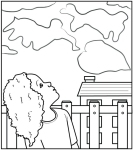By Brenda B. Covert

|
Haiku
By Brenda B. Covert |

|
| five syllables seven syllables five syllables |
| Yesterday I ate | 5 - Yes/ter/day/I/ate |
| breakfast and grabbed my backpack | 7 - break/fast/and/grabbed/my/back/pack |
| to hurry to school | 5 - To/hur/ry/to/school |
| Pancakes with syrup | 5 - Pan/cakes/with/sy/rup |
| Winter's chill delayed awhile | 7 - Win/ter's/chill/de/layed/a/while |
| The bus driver honks | 5 - The/bus/dri/ver/honks |
 |
Create Weekly Reading Books
Prepare for an entire week at once! |
| Leave your feedback on Haiku (use this link if you found an error in the story) |
 |
Clouds
|
 |
Weather
|
 |
Poetry
|
 |
Science
|